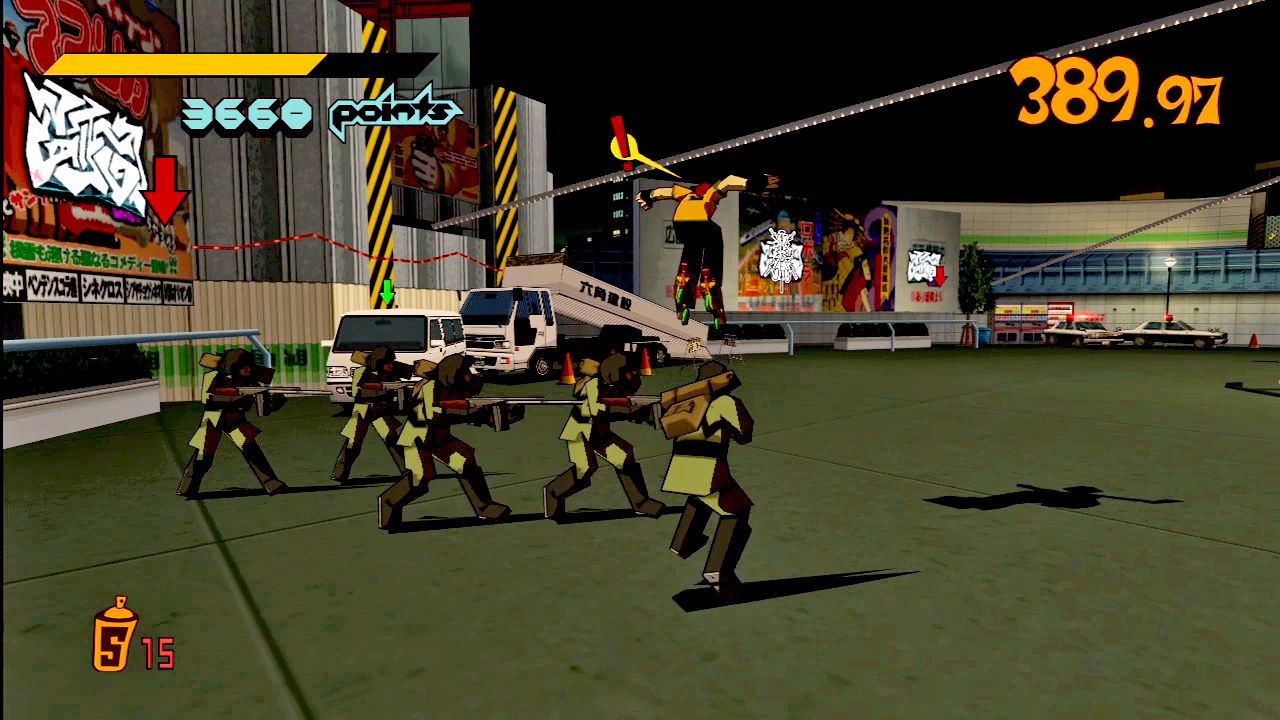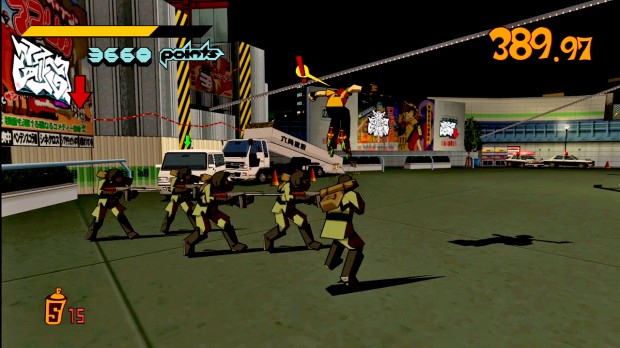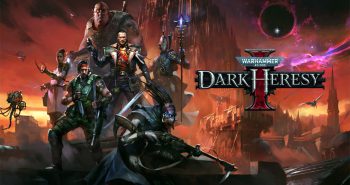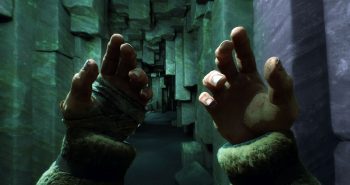The Sega Dreamcast was a beloved machine by many people back in 1999. Having only survived the vicious video game market for three years, the Dreamcast was home to some of the most memorable video games in history. Games like Crazy Taxi, Space Channel 5, Rez, Shenmue, and Phantasy Star Online all made the Dreamcast a blast to play, but in the end, could not save it from cancellation. This led many people to look back at the life of the Dreamcast and wish that they still had copies of these games. Thanks to Microsoft and Sega, these old Dreamcast games are beginning to be resurrected on the Xbox Live Arcade. The newest release is my all time favorite Sega game, Jet Set Radio.
Story:
Jet Set Radio, or Jet Grind Radio as it was called on the Dreamcast, is set in futuristic Tokyo-to, Japan and focuses on small groups of “rudies”, or juvenile criminals that want nothing more then to hang out, skate their turf, and tag graffiti on anything that will stand still for a minute. The story focuses on the GG’s, a group of rudies from the Shibuya-cho district, who is defending their turf from the other rival groups in the area, the Poison Jam from Benten-cho and the Noise Tanks from Kogane-Cho. You begin the game as Beat, a 17 year old male who has run away from home and has decided to start his own group of rudies by first recruiting Tab and Gum. After you gather your group together, you set off to make sure the world knows that Shibuya-cho belongs to the GGs and defend your turf from the other invading groups. That is, after you have completely taken Shibuya-cho from the Love Shockers, a group of girls who have been spurned by love.
Tokyo-to has their own graffiti task force that is dedicated to stopping these groups of rudies and their turf wars and send in these troops whenever they can. This task force is lead by Captain Onishima and can be a tenacious group that does not hesitant to open fire on a bunch of kids armed with spray cans. The last character in Jet Set Radio to make any impact on the story is Professor K, the DJ of a local pirate radio station that acts as both narrator and soundtrack for the entire game.
The story for Jet Set Radio is simplistic at best, but for this type of game it is exactly what I would both want and expect. You play as a kid that is hanging out on the streets with only one goal, to protect his turf while expanding it into other territories. What is fantastic about Jet Set Radio is the way that Sega choose to portray this life, without violence on the part of the gang members. The only ones that use weapons of any kind are the police that show up to try to capture you, or kill you as in the case when Captain Onishima shows up with his .357 Magnum. The gangs of Tokyo-to solve their territorial disputes with graffiti and skating tricks. All to one of the best soundtracks I have ever heard in a game.
With many games that I played as a younger man, I was 26 when the original came out, I began playing the XBLA version with some trepidation. Did I love Jet Grind Radio because of nostalgia? How will this reproduction hold up to my memories of the original on the Dreamcast? It held up amazingly well. I couldn’t help but to smile as I was playing Jet Set Radio, like I was hanging out with an old friend I hadn’t seen in twelve years.
Game Play:
Jet Set Radio’s game play is pretty much the same throughout the whole thing. You select your character, and your character list grows and your gang gets more reputation and more people join, then head off to the level to complete a number of tasks. As you are trying to tag all of the areas in the level that you need to tag, you have to keep an eye out for the police, who will try to capture you, and the rival gangs of the area, who are tagging over your marks. Once you have tagged all of the markers in the level, you move back to your hideout and then off to the next area.
Each section has a time limit that you must complete the level in, just like most Sega games of that era. This can get frustrating when you are trying to tag that last, hard to reach marker and have no idea how to get up there to hit it. The level is also filled with spray cans, yellow cans which refill your paint level to allow you to tag and red cans which refill your health meter. These are scattered throughout the level and are collected mostly by grinding the various rails and edges placed around the city. You spend most of your time avoiding combat, but when you do have to put someone in their place, it takes the form of a chase scene, where you skate after the boss and tag him until he gives up.
The game controls for Jet Set Radio are simple and handle the game quite well enough. You pretty much just have a jump button, tag button, and a boost button to worry about, with the sticks controlling direction. The only issues I had with this game were the same ones I remember having at it’s original launch, and that was perception and camera controls. I have a hard time seeing where exactly to land to hit a rail and start a trick chain, or what angle I need to hit the wall for a wall ride. The other issue with Jet Set Radio is that it is damn near impossible to efficiently see your surroundings. I find myself being surprised and grabbed by they police, simply because I could not see them coming. Jet Set Radio does give you the classic “Sega Arrow” to help direct you to the nearest threat, but you never know just how close they are until they snag your skates. Besides these two small gripes, the game play mechanics for Jet Set Radio work well enough to get the job done, without being memorable in either a positive or a negative way.
You can unlock more music by finding the music icons throughout the game. You can also unlock different tags as you progress too, or use the graffiti creator to create your own mark. You have three marks in game, small, medium, and large. The game allows you to truly get into the spirit by giving you a fairly robust graffiti creator so that you can personalize all three of your tags.
Aesthetics:
Jet Grind Radio, and therefore Jet Set Radio, is a cell shaded video game. Cell shading is the aesthetic of creating a video game to make it look like a playable cartoon. Bright colors and heavy black outlines help project this effect for the player and was a massive hit as the video game industry entered the 2000s. Jet Grind Radio is, arguably, the very first game to be released using the cell shading technique and it looks fantastic to this day. This reintroduction with Jet Set Radio means that the graphics have been tightened up and released in full high definition, so the game looks even better then it did in 2000. Cell shading was a big hit for a while, just like the idea of bullet time, until it started to get very overused. Many games would use cell shading just to cash in on the popularity of certain hit games. However, with Jet Grind Radio being one of the first to use this method, it fits perfectly into the design aesthetic and really creates a unique world to skate through and graffiti.
Voice acting in Jet Set Radio is very minimal, with most characters doing nothing more then grunts or single word shouts. The only person that is fully voice acted is Professor K, who just continues to bring a unique aesthetic to the game. Acting as narrator, Professor K adds to the aesthetics of Jet Set Radio with his pirate radio persona, giving you the feel that he is the driving force in the youth rebellion in Tokyo-to. He also is the DJ and soundtrack for Jet Set Radio, which features both original and licensed music from around the world. The music comes from many different genres, including Trip-Hop, J-Pop, Metal, Dance, and Funk. The exact soundtrack differed depending on the location of the release for Jet Set Radio, and Sega has been able to work in all of the licensed music from the original into this re-release. To some of you out there that aren’t familiar with the music scene twelve years ago, some of this may sound out of date. But for me, who’s taste in music tends to avoid today’s artists, this soundtrack is nothing less then the perfect soundtrack for this game. Every song in this game works well for me, and brings the world of Jet Set Radio to life.
Final Thoughts:
Jet Set Radio is proof that not everything we liked in the past is only good because of our sense of nostalgia. While the game play mechanics just merely work for me and get the job done, it is the aesthetics of Jet Set Radio that truly found a place in my heart and made this update and re-release absolutely necessary for me. This game is art. It looks different then any other game did in 2000, when it originally was released, and speaks volumes of the idea of a youth revolution against what is perceived as the oppressive adult culture of this society. Jet Set Radio truly explores the idea of the evolution of what art is, both in the idea of urban street art through graffiti, and the idea of the video game as art by creating a whole new look that was revolutionary for it’s time. Looking at this game today versus other more current games, I can see that the mechanics feel aged and outdated, but the game itself feels just as relevant and new as it did twelve years ago. Jet Set Radio is a must have for anyone that is interested in seeing a piece of video game art that might have been missed by many who was not lucky enough to own a Dreamcast twelve years ago. Jet Set Radio is available now for the Xbox Live Arcade for 800 Microsoft Points ($9.99).






